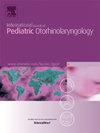儿童实体瘤患者铂致耳毒性:年幼和男性儿童更易受影响
IF 1.2
4区 医学
Q3 OTORHINOLARYNGOLOGY
International journal of pediatric otorhinolaryngology
Pub Date : 2025-02-26
DOI:10.1016/j.ijporl.2025.112292
引用次数: 0
摘要
本研究的目的是探讨中国铂类药物致耳毒性的患病率和危险因素,描述耳毒性的严重程度,并量化铂类药物的累积剂量。本回顾性研究纳入108例接受含铂化疗的儿童实体瘤患者。我们利用logistic回归来识别风险因素。采用受试者工作特征曲线(ROC)确定铂类药物累积剂量的阈值。检查了不同性别和年龄组的听力阈值。总体而言,37.04%的患者有耳毒性。男性患病率(46.43%,p = 0.036)高于女性。顺铂累积剂量是耳毒性最显著的危险因素(p = 0.002, OR = 1.29,每100 mg/mm2)。顺铂累积剂量的临界值为220 mg/m2。另一个危险因素是男性(p = 0.037, OR = 2.54)。男性在8 kHz时的听力阈值较高(61.81±15.05 dB HL;P = .042)高于女性。≤3岁组在6khz[66.00±9.37 dB HL]和8khz [70.00 (65.00,80.00)dB HL]时的耳毒性较年龄较大组(4 ~ 6岁)在6khz和8khz时更为明显。中国儿童含铂化疗患者耳毒性普遍存在,受药物累积剂量、性别和年龄的影响。累积剂量的阈值值得注意。本文章由计算机程序翻译,如有差异,请以英文原文为准。
Platinum-induced ototoxicity in pediatric patients with solid tumors: Younger and male children are more susceptible
The purpose of this study was to explore prevalence and risk factors of platinum drug-induced ototoxicity, delineate the severity of ototoxicity, and quantify the cumulative dose of platinum-based drugs, in China. This retrospective study involved 108 pediatric solid tumor patients who underwent platinum-containing chemotherapy. We utilized logistics regression to identify risk factors. A threshold for the cumulative dose of platinum-drugs was determined by ROC (receiver operating characteristic curve). The hearing thresholds across sex and age groups were examined. Overall, 37.04 % of patients had ototoxicity as measured audiometrically. The prevalence of males (46.43 %, p = .036) was higher than that of females. The cumulative dose of cisplatin was the most significant risk factor for ototoxicity (p = .002, OR = 1.29, per 100 mg/mm2). The cut-off value for the cisplatin cumulative dose was 220 mg/m2. Another risk factor is male (p = .037, OR = 2.54). The hearing thresholds at 8 kHz were higher in males (61.81 ± 15.05 dB HL; p = .042)than in females. The group of patients≤3 years old showed more pronounced ototoxicity at 6 kHz [66.00 ± 9.37 dB HL]and 8 kHz [70.00 (65.00,80.00)dB HL] than the older group (4–6 years)at 6 kHz and 8 kHz. Ototoxicity in pediatric patients with platinum-containing chemotherapy is ubiquitous in China, which is influenced by cumulative dose of drugs, sex and age. The threshold of cumulative dose deserves attention.
求助全文
通过发布文献求助,成功后即可免费获取论文全文。
去求助
来源期刊
CiteScore
3.20
自引率
6.70%
发文量
276
审稿时长
62 days
期刊介绍:
The purpose of the International Journal of Pediatric Otorhinolaryngology is to concentrate and disseminate information concerning prevention, cure and care of otorhinolaryngological disorders in infants and children due to developmental, degenerative, infectious, neoplastic, traumatic, social, psychiatric and economic causes. The Journal provides a medium for clinical and basic contributions in all of the areas of pediatric otorhinolaryngology. This includes medical and surgical otology, bronchoesophagology, laryngology, rhinology, diseases of the head and neck, and disorders of communication, including voice, speech and language disorders.

 求助内容:
求助内容: 应助结果提醒方式:
应助结果提醒方式:


